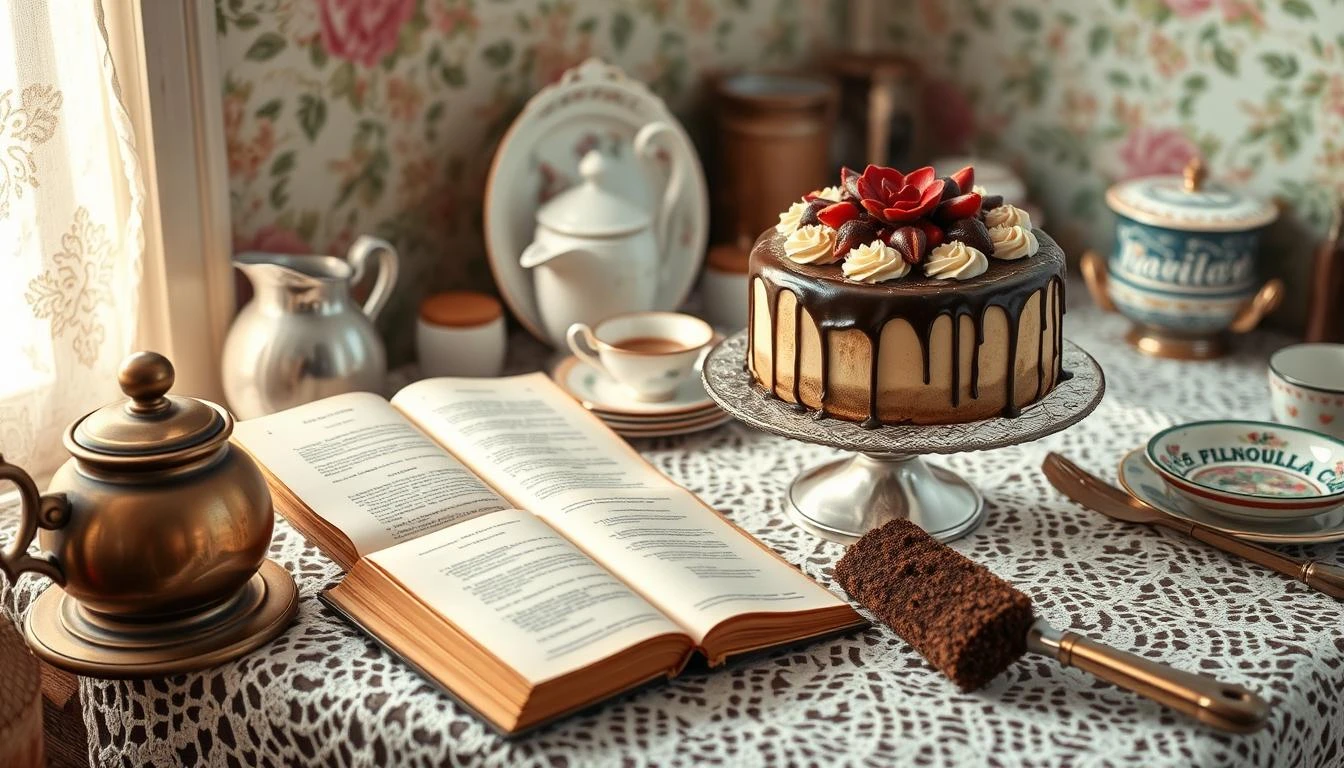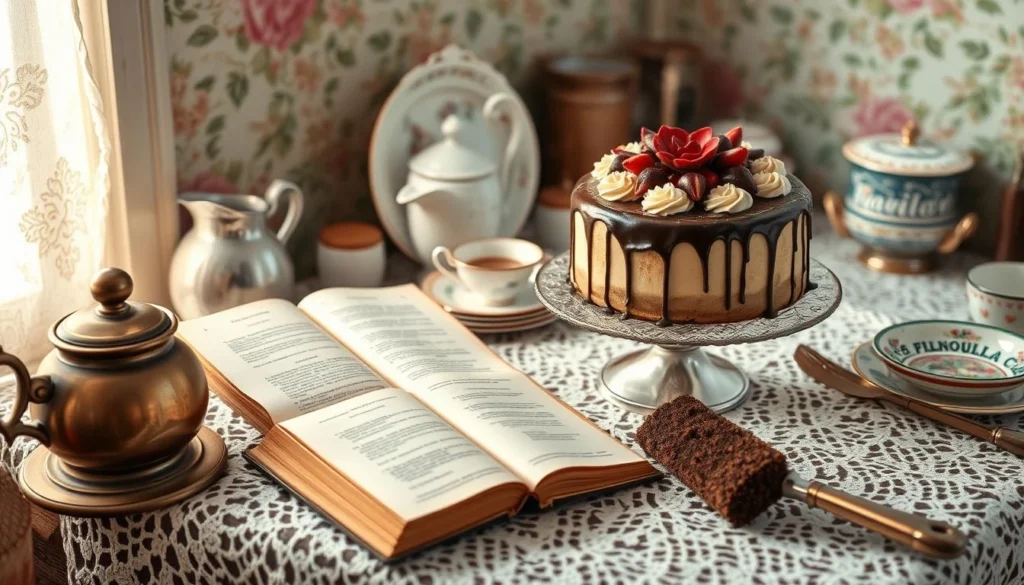
When I found my grandmother’s old recipe box, it took me back to the 1920s. The worn index cards told stories of a time when baking was a big deal. It was a world of vintage baking that captured American hearts. The 1920s chocolate cake recipe was more than a dessert. It showed the creativity and resourcefulness of the time. Home bakers made delicious treats with just a few ingredients, creating lasting family memories.
These classic cake recipes showed the spirit of a new America. Cocoa powder made chocolate cakes easy to make for families everywhere. These recipes were about more than food; they were about joy and connection.
Exploring these historical desserts was like stepping into a different world. The chocolate cakes of the 1920s inspire bakers today. They remind us that good cooking never goes out of style.
The Rich Heritage of Depression-Era Baking
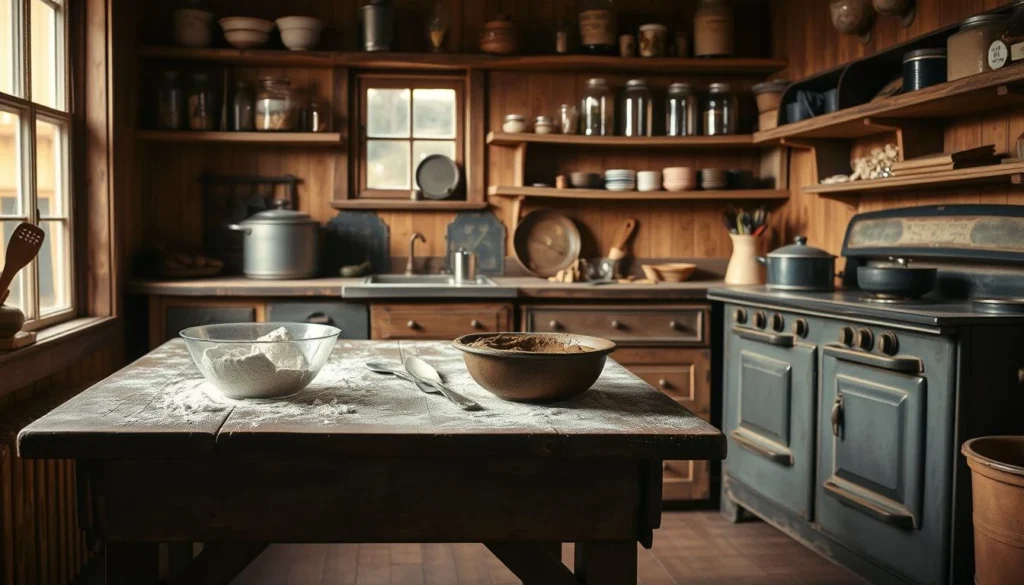
The Great Depression changed American baking in amazing ways. Families used baking to find hope and comfort. It was a way to make the tough times a little brighter.
Depression-era baking was a lifeline for many. It turned simple ingredients into tasty treats. Home bakers got creative, making delicious desserts with what little they had.
Impact of Prohibition on Home Baking
The Prohibition era changed home baking a lot. It made baking a way for families to find joy together. Bakers came up with new recipes that showed off their creativity and community spirit.
- Resourceful ingredient substitutions
- Simplified recipe techniques
- Community recipe sharing
- Affordable dessert creation
Evolution of American Dessert Culture
Chocolate cakes went from being a luxury to a comfort food. Bakers found ways to make them delicious with just a few ingredients. This made budget-friendly desserts that everyone loved.
Social Significance of Chocolate Cakes
Chocolate cakes were more than just food. They were symbols of hope and togetherness. They brought families together, sharing warmth in hard times.
Today, the vintage chocolate depression cake is loved by many. It has a 4.88 out of 5 rating from 16 home cooks who enjoy making it.
Essential Vintage Baking Equipment and Tools
Exploring early 20th century cuisine reveals a world of culinary innovation. Making an antique 1920s Chocolate Cake needed specific tools. These tools defined the era’s baking techniques.
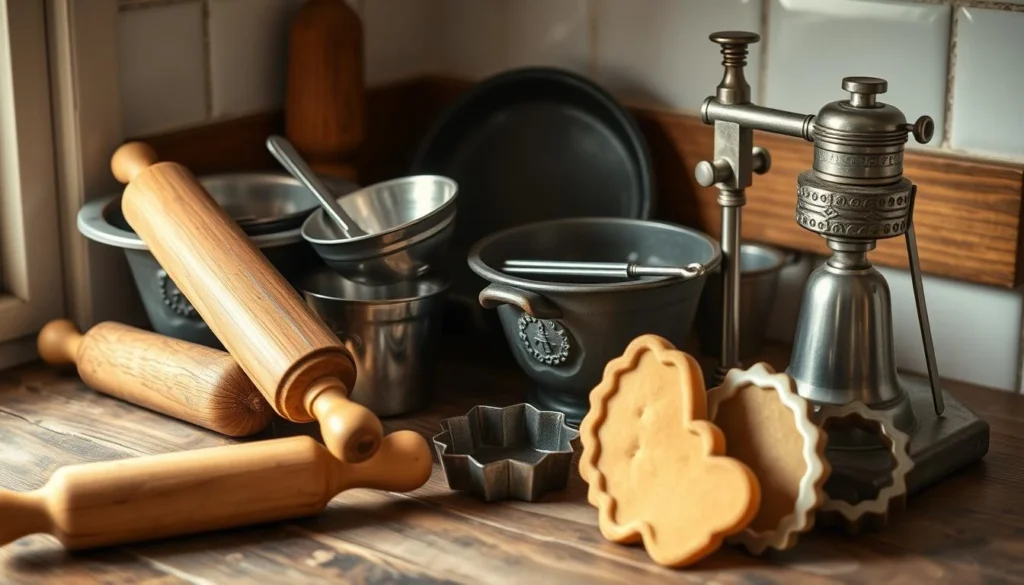
The 1920s kitchen was full of specialized baking tools. Let’s look at the key tools that made vintage baking an art form:
- Cast-iron skillets – Perfect for even heat
- Hand-cranked mixers – For precise control
- Wooden spoons – Great for gentle mixing
- Flour sifters – For smooth ingredients
Measuring became key in traditional American baking. Standardized measuring cups and spoons changed home cooking. They allowed bakers to make recipes consistently.
| Vintage Baking Tool | Primary Function | Unique Characteristic |
|---|---|---|
| Wood-burning Stove | Baking Heat Source | Needed Expert Temperature Management |
| Hoecake Pan | Creating Thin Cake Layers | Made Delicate Cake Textures |
| Hand Mixer | Mixing Ingredients | Had Manual Precision Control |
Knowing about these tools gives us a peek into the Roaring Twenties’ culinary creativity. Each tool had a story of innovation. It turned simple ingredients into amazing desserts that inspire bakers today.
Recipe for 1920s Chocolate Cake: Original Ingredients
Exploring vintage baking takes us on a journey through time. We discover the authentic ingredients of antique chocolate cake from the 1920s. This era’s classic cake recipes are truly remarkable.
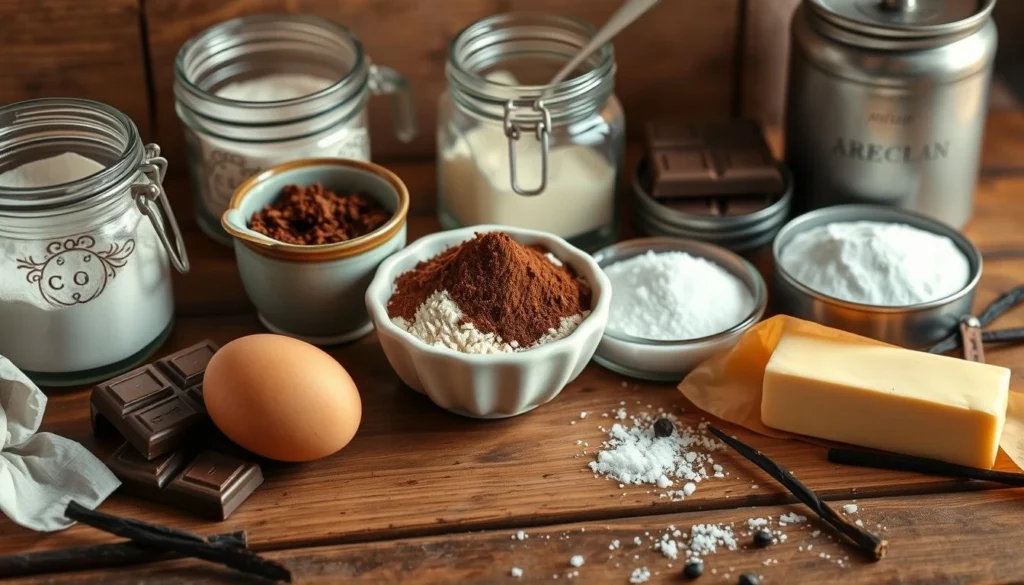
Understanding Period-Specific Measurements
Baking in the 1920s was an art form. Recipes used tools unlike today’s. Home bakers used:
- Teacups instead of standard measuring cups
- Handcrafted spoons for precise ingredient portioning
- Visual estimation techniques passed down through generations
Authentic Ingredient Sourcing Guide
The true essence of vintage 1920s Chocolate Cake comes from its ingredients. Seek out traditional components for a 1920s feel:
| Ingredient | Vintage Source | Modern Equivalent |
|---|---|---|
| Cocoa Powder | Baker’s Premium Unsweetened Baking Chocolate | High-quality unsweetened cocoa powder |
| Buttermilk | Fresh farm-churned buttermilk | Cultured buttermilk or milk + vinegar substitute |
| Butter | Local dairy churned butter | Organic unsalted butter |
Modern Halal Substitutions
Adapting vintage baking for today’s diets requires creativity. For halal options, try these:
- Plant-based milk mixed with vinegar as buttermilk alternative
- Olive oil in place of traditional butter
- Pure vanilla extract for authentic flavor
The charm of historical desserts is their ability to evolve while keeping tradition. My vintage chocolate cake recipe connects us to a rich culinary heritage. It invites bakers to explore the 1920s world of confectionery.
Preparing Your Kitchen the Old-Fashioned Way
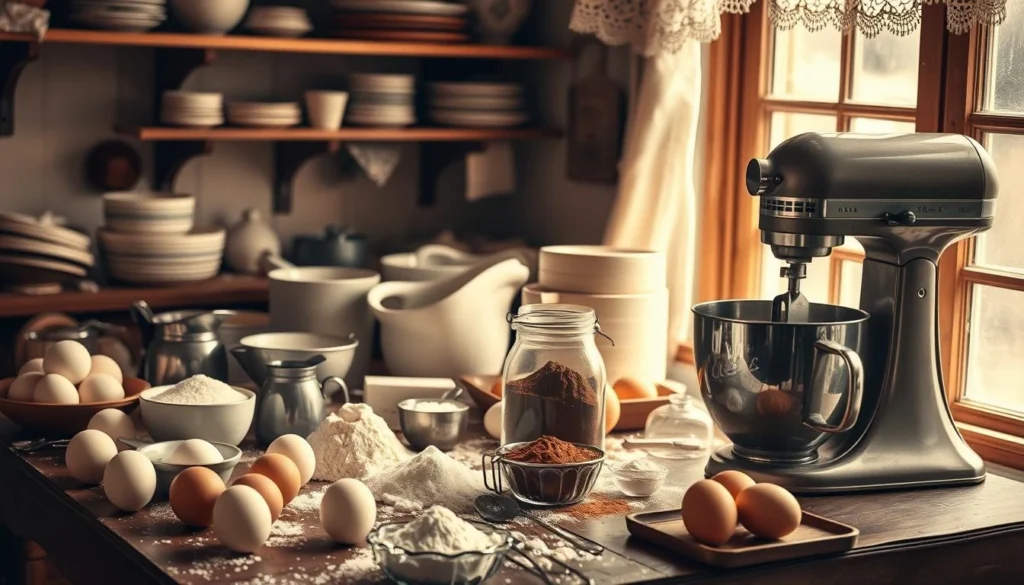
When you start making vintage desserts, setting up your kitchen is key. It’s all about capturing the spirit of traditional American baking. Let me show you how to turn your modern kitchen into a place that honors old-fashioned baking.
Begin by setting up your baking station with tools that tell a story. You’ll need:
- Wooden mixing bowls with character
- Cast-iron cake pans passed down through generations
- Vintage measuring cups and spoons
- Sturdy wooden spoons for hand mixing
Temperature and preparation are important in timeless desserts. Make sure your ingredients are room temperature for the best cake texture. Lay out all your ingredients before you start. This careful planning is like following your grandmother’s recipes.
Wear a classic apron to connect with home bakers of the past. Open your windows to let the amazing smells of your baking fill the air. This will make your baking feel like a journey back to the golden days of American home cooking.
Your kitchen is now set to make a delicious piece of culinary history!
Traditional Mixing Methods and Techniques
Making an old-fashioned chocolate cake needs you to learn vintage baking tricks. These tricks turn simple stuff into a tasty treat. Mixing is key in classic cake recipes, needing precision and old-school methods.
Vintage baking asks for detail and special mixing ways. These ways help your old-fashioned chocolate cake get just the right texture and taste.
Hand-Mixing Fundamentals
For a real chocolate cake feel, try classic hand-mixing. It’s all about blending ingredients right to get the best mix:
- Begin by creaming butter and sugar until it’s light and fluffy
- Add eggs one at a time, making sure they mix well
- Fold in dry ingredients gently to keep air in
- Use a wooden spoon for the old-school mix
Temperature Control Tips
Temperature of ingredients is key in vintage baking. Make sure they’re at room temperature for easy mixing:
| Ingredient | Recommended Temperature | Mixing Impact |
|---|---|---|
| Butter | 65-70°F | Smooth creaming |
| Eggs | Room temperature | Better emulsification |
| Milk | 60-70°F | Consistent batter texture |
Achieving Perfect Batter Consistency
The secret to classic cakes is the perfect batter consistency. Don’t overmix, or your cake will be too dense. The batter should be thick but smooth, dropping off a spoon easily.
By using these vintage baking tips, you’ll make an old-fashioned chocolate cake that celebrates traditional cooking skills.
The Art of Vintage Baking Times
Mastering historic baking needs precision and patience, like with a 1920’s chocolate cake recipe. Bakers back then relied on keen observation and experience for perfect results.
Vintage baking was all about timing and temperature. For a classic 1920s chocolate cake, recipes suggest specific baking times:
- Standard cake layers: 25-30 minutes of baking time
- Thinner layers: Approximately 10 minutes
- Golden-brown tops indicate proper doneness
Here are some vintage baking tips for a perfect historic chocolate cake:
- Rotate cake pans midway through baking
- Test cake doneness with a toothpick
- Cool layers completely on wire racks
| Cake Layer Type | Baking Time | Visual Cue |
|---|---|---|
| Standard Layers | 25-30 minutes | Firm, golden edges |
| Thin Layers | 10 minutes | Light golden top |
Pro tip: Some historic recipes suggest frosting cakes while they’re warm. Use boiled icing for a unique texture that captures the essence of 1920s culinary artistry.
Classic Chocolate Frosting Recipes
Let’s explore the world of vintage chocolate frostings from the 1920s. These recipes are not just about taste. They’re about bringing back a culinary experience from another time.
Boiled Icing Technique
The boiled icing method needs careful attention. Use a heavy-bottomed saucepan for a smooth frosting. It’s important to slowly dissolve sugar to avoid boiling. This makes the frosting silky and perfect for chocolate cakes.
Art Deco Decoration Methods
Art Deco decorations can turn a simple cake into a work of art. Use metallic food coloring and geometric stencils for patterns. A piping bag helps you create precise, elegant designs.
| Frosting Type | Calories (1/4 cup) | Fat Content |
|---|---|---|
| Chocolate Buttercream | 257 | 12g |
| Peanut Butter Buttercream | 318 | 20g |
| French Buttercream | 72 | 6g |
Frosting Storage Tips
- Store frosting in an airtight container
- Refrigerate for up to 7 days
- Allow to come to room temperature before using
- Whip briefly to restore original texture
Pro tip: Use leftover chocolate buttercream for pastries, brownie toppings, or fruit dips. These old-fashioned treats are incredibly versatile!
Mastering Layer Assembly and Stacking
Making perfect vintage desserts needs careful layer assembly. Over the years, I’ve found that layering is an art that requires patience and skill. It’s all about precision.
Before you start stacking your cake layers, follow these steps:
- Let cake layers cool completely at room temperature
- Level each layer with a serrated knife for even stacking
- Prepare a clean, stable work surface
- Have your frosting ready for smooth application
The key to a stunning vintage dessert is the balance of layers. Use a thin, even layer of frosting between each cake tier. This acts as a delicious “glue” that keeps the cake stable.
| Layer Assembly Technique | Key Considerations |
|---|---|
| Cooling Time | Minimum 1-2 hours at room temperature |
| Frosting Layer | Thin, even spread between layers |
| Chilling | 15-20 minutes between layer applications |
For professional results, use a turntable. This rotating platform makes cake assembly easier, allowing smooth frosting application and precise layer positioning. Chilling the cake between layers prevents sliding and sets the frosting beautifully.
Creating vintage desserts is about honoring traditional techniques while adding your own unique touch. It’s a delightful way to bring history to life in your kitchen.
Traditional Serving and Presentation Methods
Turning nostalgic treats into a feast for the eyes takes skill and a touch of old-world charm. Serving retro sweets is more than just placing a cake on the table. It’s about creating a journey back to the refined dining of the 1920s.
Period-Appropriate Garnishes
Enhance your vintage desserts with decorations that bring the early 20th century to life. Here are some authentic garnishing techniques:
- Candied violet petals scattered delicately across cake layers
- Hand-shaved dark chocolate curls
- Edible gold leaf for a touch of luxury
- Crystallized fruit segments
Vintage Table Settings
A proper presentation turns your cake into a masterpiece. I suggest setting up a nostalgic scene with:
- Intricate lace doilies as table underlays
- Antique silver cake forks
- Crystal dessert plates with delicate etching
- Bone china cake stands
Storage Solutions
Keeping your vintage desserts fresh requires smart storage. Use these traditional methods to protect your treat:
- Glass cake domes with decorative bases
- Vintage ceramic cake tins with tight-fitting lids
- Cool, dry storage areas away from direct sunlight
- Gentle refrigeration for cream-based frostings
My love for historical cooking inspires me to make every slice a story of elegance and tradition.
Troubleshooting Common Vintage Recipe Issues
Exploring vintage baking can be tricky. Classic cake recipes often come with unique challenges. I’ve learned that knowing the common problems is key to making perfect vintage chocolate cakes.
Most vintage cake issues come from measurement and baking technique differences. Let’s look at the most common problems:
- Dry Cake Syndrome
- Caused by overbaking or incorrect flour measurements
- Use precise period-specific measuring tools
- Check oven temperature accuracy
- Sunken Center Problems
- Result of underbaking or premature oven opening
- Avoid opening oven during first 25 minutes
- Use reliable leavening agents
Vintage baking needs patience and precision. The quality of ingredients and accurate measurements are key to success.
| Issue | Potential Cause | Solution |
|---|---|---|
| Uneven Layers | Inconsistent oven temperature | Use oven thermometer, rotate pan midway |
| Crumbly Texture | Incorrect flour type | Use period-appropriate flour blend |
| Dense Cake | Overmixing batter | Mix until ingredients just combine |
Remember, vintage baking is an art form. It requires practice and understanding of historical cooking techniques.
Preserving and Storing Your Vintage Cake
Learning how to store vintage desserts is key to keeping them tasty. Classic cake recipes need special care to stay fresh. This ensures your homemade cake stays delicious.
Here are some tips for storing your vintage chocolate cake:
- Unfrosted cake layers can be wrapped tightly in plastic wrap
- Store at room temperature for maximum 48 hours
- Frosted cakes remain fresh in a dedicated cake keeper
For longer storage, try these options:
| Storage Method | Duration | Recommended Condition |
|---|---|---|
| Refrigeration | Up to 1 week | Covered in airtight container |
| Freezing | Up to 3 months | Wrapped in multiple layers of plastic |
Pro tip: Always let refrigerated or frozen cakes come to room temperature before serving. This brings back their best flavor and texture. It keeps your vintage dessert tasting great.
Conclusion
Exploring this 1920’s recipe for chocolate cake has been an amazing journey. It shows the creativity of early 20th-century bakers. These classic cake recipes prove how home cooks made magic with simple ingredients.
The desserts from this time tell a story of more than just food. Each slice connects us to our culinary past. It shows how baking changed during tough times. Making this 1920s chocolate cake recipe is about more than just baking. It’s about keeping alive the traditions that shaped our cooking today.
By making these timeless recipes, we keep a piece of cultural history alive. These vintage desserts give us a peek into the cooking of the past. Whether you love baking or history, these desserts offer a sweet look into a bygone era.
FAQ
How authentic is this 1920’s chocolate cake recipe?
This recipe is very authentic. It’s based on old cookbooks like Fannie Farmer’s. It uses ingredients and methods from the 1920s.
Can I make this recipe if I have dietary restrictions?
Yes, you can make it with some changes. Use plant-based milk and vinegar for buttermilk. Choose olive oil and different vanilla extracts for other needs.
What makes 1920’s baking techniques different from modern baking?
Back then, bakers used hand-cranked mixers and wooden spoons. They measured with teacups and baked on wood-burning stoves. It was more about skill and feeling.
How long can I store this vintage chocolate cake?
Unfrosted layers last 2 days at room temperature. Frosted cakes stay fresh for 3-4 days. Refrigerate for up to a week or freeze for 3 months.
What are some common issues when baking this vintage recipe?
Issues include dry cakes and sunken centers. These happen from overbaking and underbaking. Use precise measurements and check the oven.
Are the ingredients for this 1920’s chocolate cake expensive or hard to find?
The ingredients are common pantry items. Flour, sugar, cocoa, buttermilk, and eggs are easy to find. This makes the recipe affordable and accessible.
Can I use modern kitchen equipment to make this vintage recipe?
Yes, you can! Modern tools work great. Just stick to the original recipe’s methods and ingredients.
How does this chocolate cake reflect the cultural context of the 1920s?
This cake shows the spirit of the Depression and Prohibition era. It’s made with simple ingredients, showing how bakers comforted communities during hard times.

